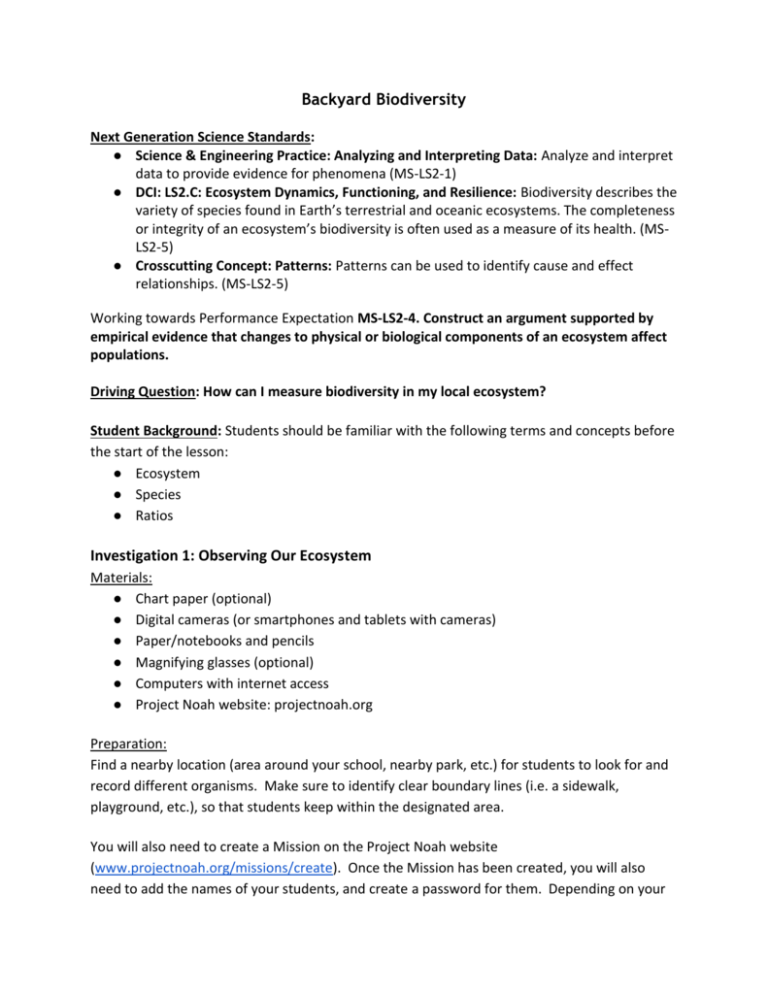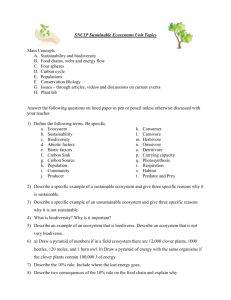Backyard Biodiversity INTERMEDIATE
advertisement

Backyard Biodiversity Next Generation Science Standards: ● Science & Engineering Practice: Analyzing and Interpreting Data: Analyze and interpret data to provide evidence for phenomena (MS-LS2-1) ● DCI: LS2.C: Ecosystem Dynamics, Functioning, and Resilience: Biodiversity describes the variety of species found in Earth’s terrestrial and oceanic ecosystems. The completeness or integrity of an ecosystem’s biodiversity is often used as a measure of its health. (MSLS2-5) ● Crosscutting Concept: Patterns: Patterns can be used to identify cause and effect relationships. (MS-LS2-5) Working towards Performance Expectation MS-LS2-4. Construct an argument supported by empirical evidence that changes to physical or biological components of an ecosystem affect populations. Driving Question: How can I measure biodiversity in my local ecosystem? Student Background: Students should be familiar with the following terms and concepts before the start of the lesson: ● Ecosystem ● Species ● Ratios Investigation 1: Observing Our Ecosystem Materials: ● Chart paper (optional) ● Digital cameras (or smartphones and tablets with cameras) ● Paper/notebooks and pencils ● Magnifying glasses (optional) ● Computers with internet access ● Project Noah website: projectnoah.org Preparation: Find a nearby location (area around your school, nearby park, etc.) for students to look for and record different organisms. Make sure to identify clear boundary lines (i.e. a sidewalk, playground, etc.), so that students keep within the designated area. You will also need to create a Mission on the Project Noah website (www.projectnoah.org/missions/create). Once the Mission has been created, you will also need to add the names of your students, and create a password for them. Depending on your students’ level of comfort with technology, you may choose to briefly introduce the website to them prior to this lesson. Background Information for Teacher: Biodiversity is the amount of variation of living things found in an ecosystem. Reduced biodiversity can impact all aspects of an ecosystem leading to issues such as overpopulation of a species, reduced variety in agriculture, and susceptibility to disease. Scientists collect data in order to track biodiversity over time, and study how these changes impact the health of the ecosystem. Instructional Sequence: Have students think-pair-share the following prompt: What living things have your observed in your neighborhood? Next, let students know that we will be studying our local ecosystem. Lead students in a class discussion and brainstorm, recording on the board or chart paper: ● What is an ecosystem? ● What is diversity? ● Is diversity of living things important for an ecosystem? Why or why not? (Note: Encourage students to develop their own definition of these terms, and build on one another's ideas. These questions are meant to provide insight into students’ thinking for the teacher, and to address any misconceptions, or unclear understandings, during instruction.) Explain to students that they will be going into part of their local ecosystem, and observing as many different types of organisms as they can find. Encourage students to look for differences within a species -- for instance a variety of different birds, trees, fungi, etc. Ask students: What are some things we can look for to identify variation in a species? You may find it helpful to show a few images of variation in categories to help students practice, for instance differentiating between an oak and a maple tree. Students will now go outside and explore the designated area, photographing and recording observations of as many living things as they can find. Students should be detailed in their observations in order to make the most accurate identification as they can. Encourage students to carefully look under rocks, and inspect trees for insects and fungi. Back in the classroom, students will use online resources to identify the different organisms they found. Introduce students to the Project Noah website, and have them log in to the class Mission page. Let students know that they will now be uploading a picture of each different type of organism they found. They will use Project Noah and other online resources (see below) to figure out what the organism is, and record it with their picture. Before they get started, lead the class in a brief discussion to guide their research: ● What are some research strategies to help identify an organism? ● How can you narrow down your search? ● What might you rule out of your search? For instance, if I’m looking for a type of bird, how can I eliminate, say, penguins from my results? (Discuss habitat, and our local climate) After students have logged their organisms, have a final wrap-up discussion about their findings: ● What are some organisms you found in our ecosystem? ● What are some things you notice about what we observed? ● What are some things you wonder about the living things in our ecosystem? Have students complete and submit an Exit Slip answering the following prompt: Describe the species diversity you observed in our ecosystem. Do you think this diversity is important for the ecosystem? Why or why not? Sample Online Resources: - Project Noah: www.projectnoah.org - Animal Arkive: www.arkive.org - Encyclopedia of Earth: www.eoearth.org - WWF WildFinder: www.worldwildlife.org/science/wildfinder Accommodations: You may provide some or all students with a graphic organizer to help guide them while they document species within their ecosystem. A simple chart listing different types of living things (trees, animals, birds, insects, plants, etc.) will help to organize students’ data, and also gently remind them to observe many different types of living things. Assessment: Students’ understanding will be assessed by their answers to discussion questions, both during whole class discussions, as well as one-on-one, and also by their Exit Slip. Students’ understanding of biodiversity and its importance is first gauged at the beginning of class in discussion, and again at the end in the Exit Slip. If students’ misconceptions persist to the end of the lesson, they should be addressed in the second investigation. Investigation 2: Data Analysis Materials: ● Paper/notebooks and pencils ● Clipboards (optional) Preparation: Have a good estimate of the square footage of the area students will be surveying. This will be used when students are calculating ratios and estimating population size. As an accommodation for some students, or to save time, you can prepare a collection table ahead of time. This will allow more class time for students to collect and analyze data. Instructional Sequence: Begin this investigation by asking students to summarize what we found when we observed our local ecosystem. Next, ask students: Which type of organism in our ecosystem do you think had the most diversity? Have students share their thoughts, then ask them: How can we better analyze the diversity in our ecosystem? We have observed our ecosystem, what other strategies can we use? As students discuss ideas, guide them towards the collecting of quantitative data. By collecting and comparing data, we are better able to communicate with others what we observed. Students will look over the organisms that they observed in the prior investigation and create a chart to keep track of the number of each present in their ecosystem. They will then take their chart outside to track the number of individual organisms they see. (Note: Depending on the time available or your students’ needs, you may decide to assign each student a different set of species in order to collect data on a wider array of organisms.) Sample Collection Table House Sparrow III American Homer Pigeon II N. American Gray Squirrel I Oak tree IIII I Upon returning to the classroom, call on students to share some of their data and compare it to what their classmates found. Guided discussion questions: ● Were you surprised by the data you collected? In what way? ● What do you notice about our class’ data? ● Which species appears to have the highest population size in our ecosystem? Why might this be? ● What are some of the limitations of this data? Was our sample size large enough? Next, students will calculate and compare the ratios of organisms found in their local ecosystem. Walk students through an example of finding a ratio, and using it to make a projection or estimate (i.e. I found 4 house sparrows in our 500 sq. ft. ecosystem. I could say that there are 4 sparrows for every 500 sq. ft., or 4:500. How could I estimate for 1,000 square feet?) Students will now calculate ratios based on their data, you may wish for them to work independently or with a partner. Below are a few sample questions to guide students’ work: ● If you found 10 oak trees in our 500 square feet ecosystem, how many would you estimate might be found in 5,000 square feet? Use ratios to help you. ● What are the limitations to this model? Why might it be inaccurate? ● Can you think of improvements for approximating the population size of a species in a given area? ● What other ways can we use ratios with our data? Find three other comparisons using the data you collected. Write a sentence to explain what it is comparing, and what it might tell us about our ecosystem. Finally, lead students in a whole class discussion about their findings: What conclusions can you draw from our data? Why might there be more of X species and less of Y species (use findings from their data)? What might happen if the number of Y species doubled? Why might biodiversity be important? After a brief discussion, have students write up a conclusion of their findings for the day. In their conclusion, students should use their data to write an explanation for what biodiversity is, and population sizes they observed in our local ecosystem. In the follow-up lesson, Backyard Biodiversity - Food Webs, students will dig deeper into analyzing the importance of biodiversity, and the interconnectedness between species. Accommodations: You may choose to provide some or all students with a pre-created table for students to use while collecting their data. You may also wish to assign students specific species to collect data on, in order to limit the number of species they must find and count; students would then share their findings as a class in order to compile all of the data. Some students may benefit from the use of a calculator to calculate ratios using their data; the focus of this lesson should be on their understanding of biodiversity, rather than computation. Assessment: ● Formative: Students’ understanding will be assessed by their answers to discussion questions, both during whole class discussions, as well as one-on-one. ● Summative: Students’ understanding will be assessed by their collection and dissemination of data, and in their final written conclusion. Students’ learning will be evidenced in by their ability to analyze the data in order to explain biodiversity, and compare the population sizes of two or more species in our ecosystem. Optional Extension: Students can develop a graphic representation of their data by creating a pie chart or bar graph. They can choose what they would like to compare, and write a description of what their data shows, and what it might mean about the ecosystem. Related Follow-Up Lesson: The learning that takes place in this lesson can be built upon using the Backyard Biodiversity Food Web lesson plan. In that lesson, students construct a model showing the transfer of energy within their local ecosystem. They then use this model to predict how a decrease in one species population would impact the rest of the ecosystem over time.








